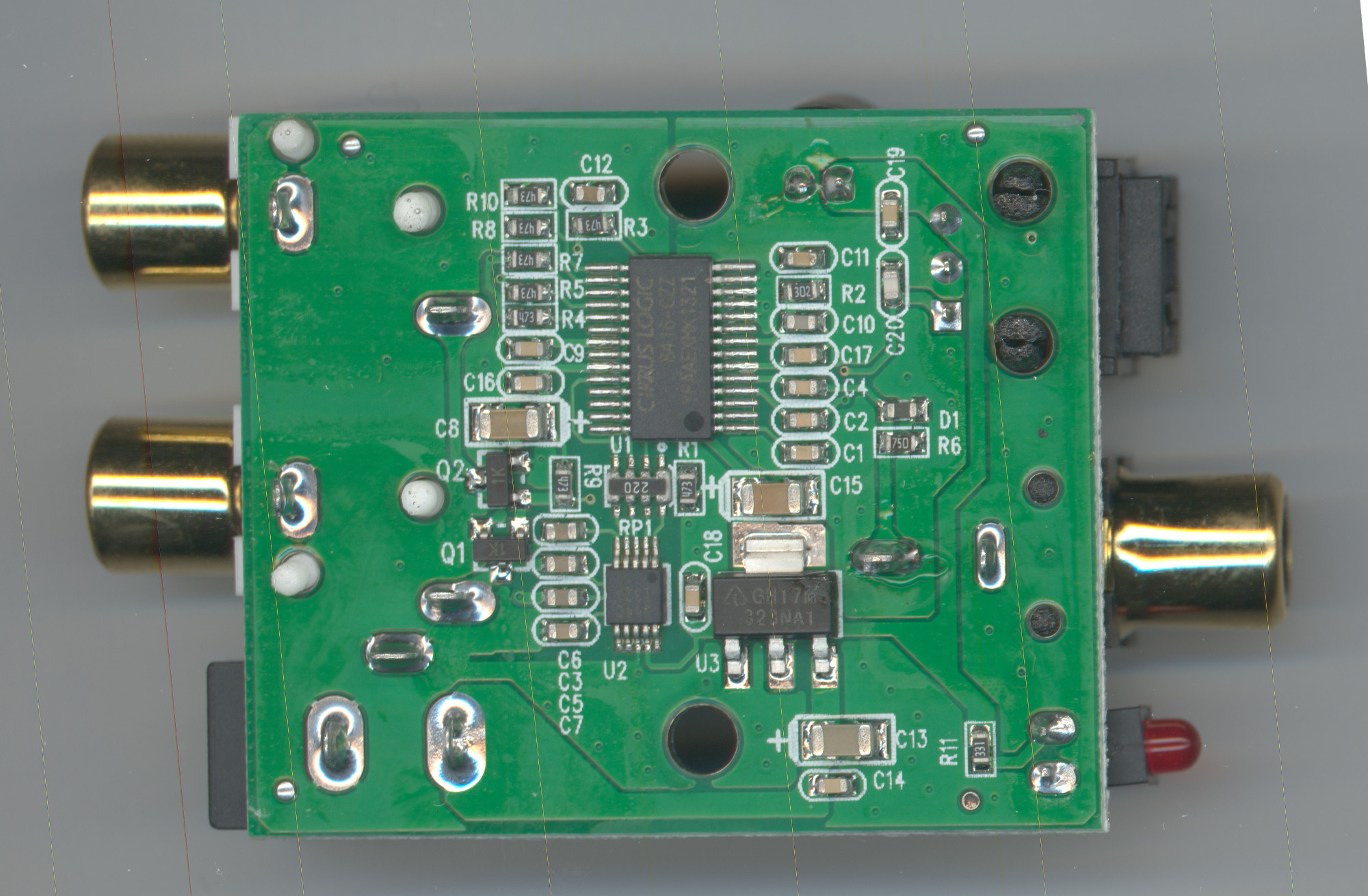This is a review and detailed measurements of the Amazon Basics "192 kHz" Toslink optical and Coax input DAC. I purchased it on member suggestion and costs US $14.

Can't expect more given the price and functionality. As noted there are dual inputs (NO USB -- USB is for power only):

An RCA to 3.5mm adapter cable is included presumably for headphone use.
It is interesting to see full regulatory certification and manufacturing in Vietnam:

I would think if it is just a rebranded generic DAC, it would have come from China.
Amazon Basics DAC Measurements
As usual, we start with our Dashboard, feeding the DAC a 1 kHz digital tone:

I hoped for 96 dB but got 85 dB SINAD (relative sum of noise+distortion). This puts the unit solidly in the "poor" category of all DACs tested:

I was sad to see just 1 volt output. This definitely impacts any headphone listening and makes it less compatible with devices out there.
Noise floor is high by our standards but good enough for the target application:

Someone forgot to enable the output filter (or implement one):

Low level linearity is lost due to noise:

Intermodulation distortion vs level shows that it does do better at max volume than a typical (low performance) phone headphone dongle:

Jitter disturbances are quite low but that is likely due to very high noise floor hiding them:

The biggest issue was when I swept the digital input tone:

The lack of filtering is the reason at high frequencies the graph goes off the chart (the green line at 96 kHz sampling reduces this impact). So we could "forgive" that but not the rise in low frequency distortion. SINAD drops to 50 at 20 Hz! Usually this is caused by poor power supply design. They have the room here to do a good job but obviously they did not to hit a cost target or didn't know better.
I tried to run the Multitone test which is at 192 kHz but could not get the unit to accept that over either Coax or Toslink. The mention of that in the product name is therefore improper. The DAC chip no doubt supports 192 kHz but there is no way to feed it such a digital signal.
Conclusions
There are some signs of quality here given the regulatory certifications and such. I am sure that was part of the product requirement doc (PRD) Amazon gave to whoever designed this. Sadly they did not know to specify other important bits related to fidelity, resulting in a device that clearly could have been better but is not. No doubt it spits out sound though so as a "throw away" product, it works.
In this site, my goal is to find best in class product and sadly, the Amazon Basics DAC is not it. As such, I cannot recommend it.
-----------
As always, questions, comments, recommendations, etc. are welcome.
Any donations are much appreciated using: https://www.audiosciencereview.com/forum/index.php?threads/how-to-support-audio-science-review.8150/

Can't expect more given the price and functionality. As noted there are dual inputs (NO USB -- USB is for power only):

An RCA to 3.5mm adapter cable is included presumably for headphone use.
It is interesting to see full regulatory certification and manufacturing in Vietnam:

I would think if it is just a rebranded generic DAC, it would have come from China.
Amazon Basics DAC Measurements
As usual, we start with our Dashboard, feeding the DAC a 1 kHz digital tone:

I hoped for 96 dB but got 85 dB SINAD (relative sum of noise+distortion). This puts the unit solidly in the "poor" category of all DACs tested:
I was sad to see just 1 volt output. This definitely impacts any headphone listening and makes it less compatible with devices out there.
Noise floor is high by our standards but good enough for the target application:

Someone forgot to enable the output filter (or implement one):

Low level linearity is lost due to noise:

Intermodulation distortion vs level shows that it does do better at max volume than a typical (low performance) phone headphone dongle:

Jitter disturbances are quite low but that is likely due to very high noise floor hiding them:

The biggest issue was when I swept the digital input tone:

The lack of filtering is the reason at high frequencies the graph goes off the chart (the green line at 96 kHz sampling reduces this impact). So we could "forgive" that but not the rise in low frequency distortion. SINAD drops to 50 at 20 Hz! Usually this is caused by poor power supply design. They have the room here to do a good job but obviously they did not to hit a cost target or didn't know better.
I tried to run the Multitone test which is at 192 kHz but could not get the unit to accept that over either Coax or Toslink. The mention of that in the product name is therefore improper. The DAC chip no doubt supports 192 kHz but there is no way to feed it such a digital signal.
Conclusions
There are some signs of quality here given the regulatory certifications and such. I am sure that was part of the product requirement doc (PRD) Amazon gave to whoever designed this. Sadly they did not know to specify other important bits related to fidelity, resulting in a device that clearly could have been better but is not. No doubt it spits out sound though so as a "throw away" product, it works.
In this site, my goal is to find best in class product and sadly, the Amazon Basics DAC is not it. As such, I cannot recommend it.
-----------
As always, questions, comments, recommendations, etc. are welcome.
Any donations are much appreciated using: https://www.audiosciencereview.com/forum/index.php?threads/how-to-support-audio-science-review.8150/



